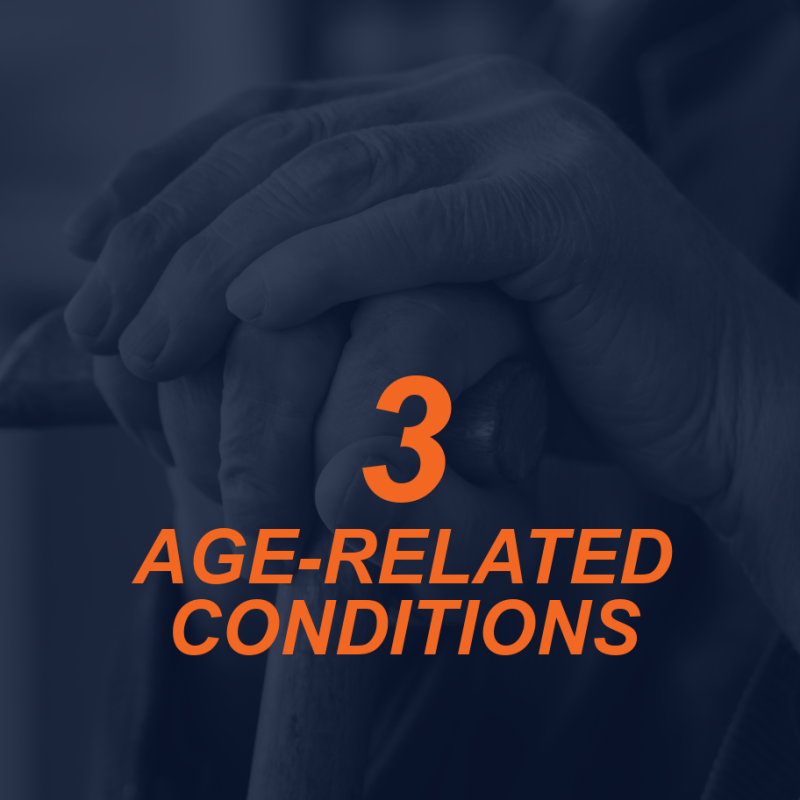
Every year, more and more seniors are starting to exercise regularly. This is a great thing as we know exercise can improve mobility, balance, strength, coordination, and decrease the risk of falls. Working with older adults is also a great niche for fitness professionals because you provide the necessary guidance and lifestyle help to improve the lives of this demographic. But, chances are your senior clients may suffer from any number of age-related conditions or diseases.
If you are training older adults, it’s important to know the common conditions they may have and how to safely work with or around them.
Listed below are some of the more common conditions you’ll see in older adults. It is important to note – not all older adults are going to have these conditions and these conditions are not necessarily only seen in older adults, it’s just that older adults are more likely to have these conditions then the rest of the population. Further, this is far from an exhaustive list of age-related conditions, but it’s.
Age-Related Condition 1: Dementia
Dementia is not a specific disease but rather a general term for the impaired ability to remember, think, or make decisions that interferes with everyday activities.
The most common type of dementia is Alzheimer’s disease. According to the CDC approximately 5.8 million people in the United States have Alzheimer’s disease and related dementias. The majority (about 97%) of cases are in people aged 65 and older. It’s important to bear in mind, however, that your client may not be aware of their mental decline or have a diagnosis of dementia to share with you. This is why it’s important to look out for the early symptoms of dementia outlined here:
- memory loss
- difficulty concentrating
- finding it hard to carry out familiar daily tasks, such as getting confused over the correct change when shopping
- struggling to follow a conversation or find the right word
- being confused about time and place
- mood changes
You may be surprised to know that dementia is not a natural part of aging, although most common in aging adults. If your client has not shared with you a diagnosis and you are noticing the above signs, you may delicately express concern for their well-being because they haven’t been themselves lately (only appropriate for clients you have been training for some time). If you are familiar with a close family member or caretaker, you may wish to have such a discussion with them instead. Otherwise, you may also suggest that your client get a check-up with a health provider in order to continue the training relationship (explaining that is protocol for you after age 65, for instance).
Tips for training people with dementia
- Always speak to the client face-to-face.
- Eye contact is a must
- Avoid chatter and unnecessary details
- Use short simple sentences
- Don’t be alarmed or offended if the client does not remember who you are
- Allow client to tell you the same stories over and over
- Behave as though each time it is new
- Use verbal, visual, and tactile cues in your instruction
- Pair verbal cues with a visual demonstration
Age-Related Condition 2: Arthritis
Arthritis is a general term for conditions that cause pain and stiffness in the joints or the tissues around the joint. There are more than 100 types of arthritis, some of the most common being osteoarthritis, rheumatoid arthritis, gout, and fibromyalgia.
According to the CDC Arthritis affects 58.5 million US adults (about 1 in 4).
Tips for training people with Arthritis
- Plan a progressive strength training program
- Small increases in intensity and resistance
- Strength training machines improve movement in weight in the right place
- Free weights require more stabilization
- Ask how they are feeling before they start their training session
- They may be experiencing a “flare”
- Use adaptive devices
- Blocks under heels / padded gloves for holding weights
- Be prepared to modify if a position becomes painful
- Painful knees = shallower range of motion in squats and lunges, or greater emphasis on open-chain movements, band work, and bridges.
Age-Related Condition 3: Osteoporosis
Osteoporosis is a bone disease that develops when bone mineral density and bone mass decrease, or when the quality or structure of bone changes. This can lead to a decrease in bone strength that can subsequently increase the risk of fractures (broken bones).
Approximately 10 million Americans have osteoporosis and another 44 million have low bone density, placing them at increased risk. Although osteoporosis is more common in women, it is still prevalent in men.
Tips for training clients with Osteoporosis.
- Plan a progressive strength training program
- Small increases in intensity and resistance
- Include balance work for falls prevention
- Avoid
- Jarring or excessive twisting
- Abrupt and sudden or high impact
- Abdominal curls or excessive trunk flexion
Summary
These are just some of the age-related conditions you’ll see if you are training older adults. It is essential to appropriately pre-screen every client and obtain medical clearance if necessary. If you’re considering specializing in this area, I’d recommend completing a senior fitness certification.






